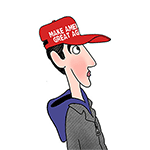NYPD Community Response Team lacks defined mission, transparency, report says
Published in News & Features
NEW YORK — An NYPD unit initially tasked with tackling quality-of-life complaints across the city has exploded in size but remains a shadow group within the department without any publicly defined parameters or mission statement, the city’s Department of Investigation said in a Tuesday report.
While the NYPD’s Community Response Team has been repeatedly hailed on social media for cracking down on illegal street vendors, ghost cars and dirt bike and ATV riders over the last two years, the group isn’t mentioned on the department’s website, DOI investigators discovered.
Nor is it easy to determine if or to what extent the group’s crackdowns actually help the communities they’re assisting — even though the team has grown tenfold in the past two years, the report notes.
“CRT has expanded significantly, with a team in every patrol borough, without a corresponding expansion of publicly available information about the work of this unit,” DOI Inspector General Jeanene Barrett said Tuesday, adding that the unit’s lack of transparency “risks noncompliance with the law, ethical breaches and negative policing outcomes.”
The DOI recommended that the NYPD immediately release a mission statement for the amorphous group on the department website, as well as information on how the department recruits and trains CRT members and evaluates team performance.
“The creation of public policies and procedures [will] enhance knowledge of and confidence in CRT’s mission, as well as facilitate future oversight,” Barrett said.
The report was the first phase of a continuing investigation of CRT, DOI officials noted. The next phase will concern how many CRT members have been disciplined or are facing discipline.
The CRT was initially formed in 2022 by NYPD Chief of Department Jeffrey Maddrey, Chief of Patrol John Chell and Deputy Commissioner of Operations Kaz Daughtry as a citywide unit “intended to respond to rising numbers of quality-of-life complaints from elected officials and community members,” according to the report.
At first, it was considered a pilot program with 16 officers and two sergeants focused on combating illegal cannabis trucks, ghost cars (cars with altered or forged license plates) and unlicensed street vendors.
But, over the last two years, the team has ballooned to 165 members and now operates in every borough, the DOI said.
Initially, the team — nicknamed the “khaki boys” for their modified uniforms, which include khaki cargo pants and shirts with the NYPD logo on them — was considered “ragtag” by one senior NYPD official for “its informal nature and lack of official status within the department,” the report noted. Unit members were in a pilot program staffed by members who were not formally assigned to CRT, but were asked to conduct CRT operations two or three times a week.
Today, the unit operates in all five boroughs and has its own unit commander. Yet, still very little is publicly disclosed about how the unit is run, what they’re tasked with doing, and how successful they are.
The recruitment procedures for the team are just as vague, the report said, noting that “there had not been an official recruitment process for CRT.”
“According to members, some officers applied, were interviewed and were temporarily transferred into the unit to see if they were a good fit,” the report states. “Other officers worked with a member of CRT before joining, which enabled them to join the unit without an interview.”
While unit leaders said their members are sent to communities with high numbers of 311 calls for quality-of-life concerns, the CRT doesn’t have a mechanism to see if the 311 calls decreased or increased following one of their operations.
Anecdotally, DOI investigators were told by the CRT members they interviewed that communities are “applauding the work of CRT officers in public, including approaching CRT leadership and officers to say thank you.”
Yet the DOI also met with “several community advocacy and violence interrupter groups who reported instances of intimidation, questionable stops by CRT, and fear of CRT by community members,” the report states, noting that investigators were “unable to speak with a fully representative sample of community members impacted by CRT’s work.”
One of the biggest supporters of CRT is Daughtry, who repeatedly cheers the unit’s work on X.
But even then, the successes Daughtry applauds vary wildly.
On Monday alone, Daughtry hailed CRT’s crackdown on illegal street vendors on Sixth Ave. in Manhattan, then applauded three CRT members for arresting a man who pulled a gun on them in the Bronx.
“Our officers in their unmarked police vehicle observed a group of men drinking alcohol on a street in the middle of the afternoon. As they watched them, one male looked at the car and asked our officers if they had a problem, removed a loaded firearm and held the gun in front of his waistband,” Daughtry wrote on X. “Our officers jumped out with their guns drawn and immediately apprehended the suspect and recovered his deadly weapon.”
Daughtry said the arrest “marks the 100th gun your Citywide Community Response Team has removed from NYC streets this year.”
The DOI sent a copy of its report to the NYPD on Nov. 7. The department has 90 days to respond to the report once it’s publicly released, a DOI spokeswoman said.
“We thank the DOI for its review of the policies and procedures relating to the Community Response Team,” an NYPD spokesman said. “We look forward to reviewing the report and carefully considering its recommendations.”
Meanwhile, Kayla Mamelak, a spokeswoman for Mayor Eric Adams, said the CRT Unit’s mission, basically, “is the same as that of all NYPD officers.”
“Our Community Response Teams were created to rapidly address New Yorkers’ concerns about safety and have been effective since day one — the report doesn’t call any of that into question,” she said. “While we are still reviewing the report, CRT’s mission is the same as that of all NYPD officers, starting with listening to the community and addressing their needs. CRT members — along with the entire NYPD — work every day to improve life in New York City by partnering with the community to enforce laws, keep the peace, reduce fear and maintain order.”
©2024 New York Daily News. Visit at nydailynews.com. Distributed by Tribune Content Agency, LLC.







Comments